A Marching Band uniform includes a jacket, bibbers, marching shoes, a shako, and gloves. If there is one uniform accessory that people complain about the most, it is the gloves.
It is hot outside, and wearing sweaty gloves can feel gross, but to be in uniform, every band kid must wear Marching Band gloves at some point.
The gloves are a band tradition and are usually one of two colors. White or black. For brass players, you will wear full gloves, and woodwinds may need to cut the fingertips off their gloves to play their instrument.
Some companies make half-finger gloves for woodwinds, but chances are you will have to cut the tips off of a pair of gloves to match the brass players.
You can buy Marching Band gloves from any marching band supply company online or on Amazon. They are relatively easy to purchase and have many styles.
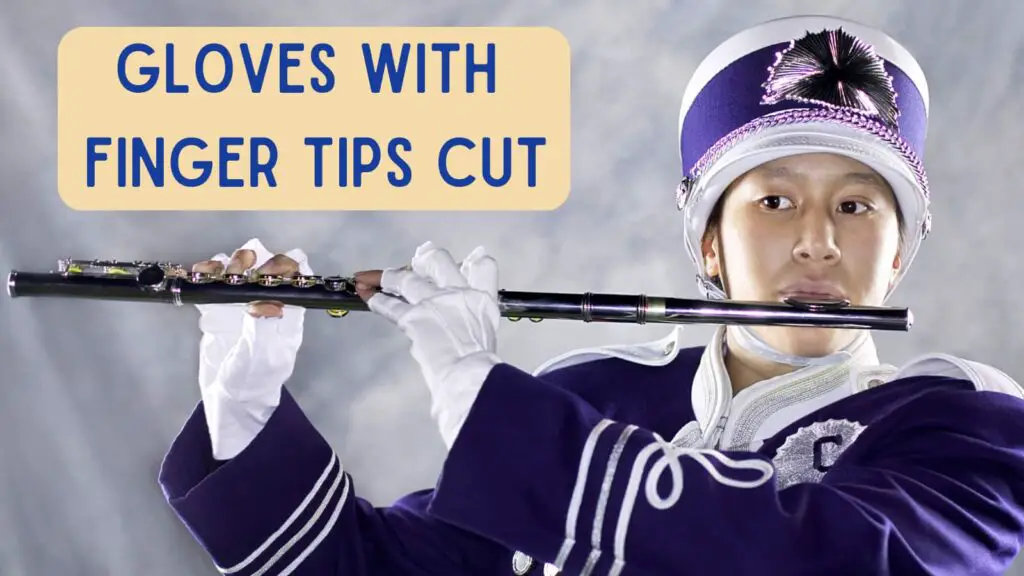
The best gloves for Marching Band are lightweight cotton gloves that are either white or black. Your band director will let you know if you must wear anything other than white or black cotton gloves.
Tip: Wait until you have tried on your uniform before buying gloves so you know which ones to get!
Why Do Marching Bands Wear Gloves?
There is no single reason why Marching Bands wear gloves, and they are worn for various reasons.
One of the first reasons why Marching Bands wear gloves is because Marching Bands evolved from military bands. Military musicians wear dress uniforms when they perform, and part of a military dress uniform is a pair of white gloves.
Like plumes and spats, wearing Marching Band gloves are a tradition, something you just do because it has always been done that way in the past.
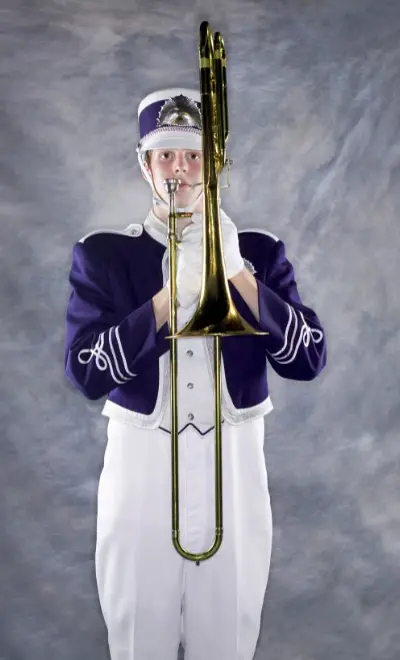
Another reason why Marching Bands wear gloves is to look uniform.
Wearing gloves was a part of standard marching uniform attire, adding a nice crisp look to the whole ensemble.
The long-sleeved jackets, bibbers, and tucking your hair into your shako all work to make all the band members look alike.
The gloves do that as well. Covering the entire hand (or the palms and part of the fingertips for woodwind players) means everyone’s hands look alike.
From the shoulder to the tips of the fingers, everything is covered. There are no nail polish, rings, tattoos, birthmarks, etc., able to be seen.
When you have a large band, the gloves act as a way to minimize audience distractions. The only people who will want to watch the hands of marching band members are other musicians.
We can judge the technical difficulty of a song by studying the hands of a person playing an instrument in a crowd, but the average football fan will not be looking at the hands of one or more players. Fans look to see the shapes and design the band’s drill creates, and Marching Band gloves help keep the audience’s attention centered on the drill and let them listen to the music simultaneously.
Wearing gloves serves another purpose for Marching Bands that use silver brass instruments.
Fun Fact: Gloves help protect the finish on the horn from coming into contact with the natural oils and sweat your hands produce. Far less polishing is required if there is a barrier protecting the horn’s finish.
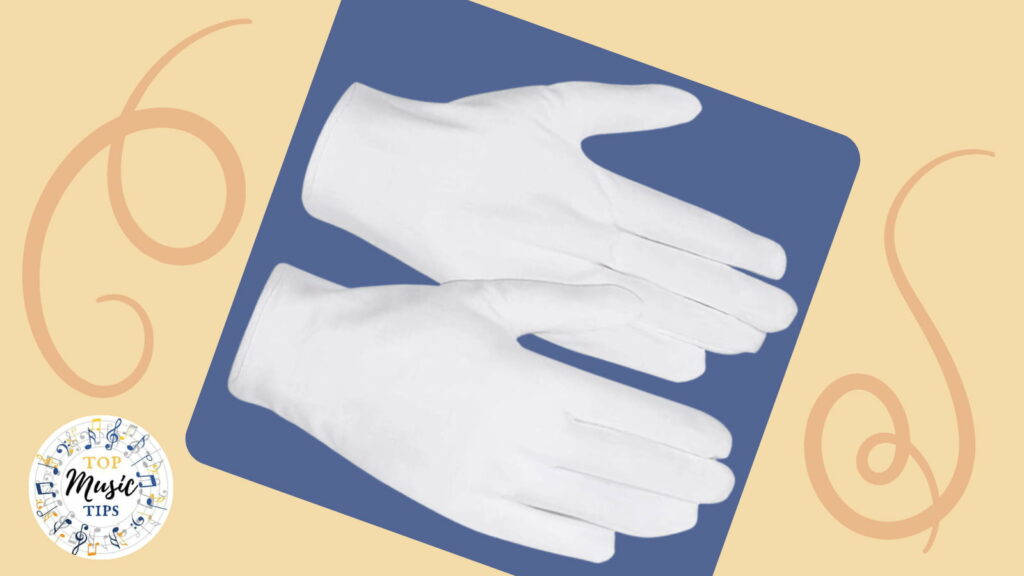
A full line of silver baritones looks really nice and uniform. What can take away from that is a discolored horn no longer has a high polish shine or looks dirty. Caring for the condition of your instrument is essential, and wearing gloves during rehearsals and/or during performances helps care for the instrument.
What Gloves Do Drum Majors Use?
Not all drum majors wear gloves. Some uniforms are designed in a specific way, and wearing gloves with them can look odd. That being said, you are likelier to see drum majors with gloves on during performances or halftime than bare hands. It is up to the band director to decide if they want their drum majors to wear gloves or not.
We are going to let you in on a drum major secret… they wear the same gloves as the rest of the band.
There might be some style differences, like the length of the glove may extend further than the wrist bone, or they might have three seams on the tops of the hands, but there are no special drum major gloves.
If your band has dark uniforms and wears black gloves, the drum major may wear white gloves to make their hands easier to see from the podium.
🎵 Note: Some drum majors like to use golf gloves instead of the standard cotton band gloves because they are more fitted, retain their shape, and are more durable than cotton gloves.
Again, this is merely a preference and can be what the drum major has chosen to wear. The drum major’s and the rest of the band’s gloves will be a single color and be worn marching into the stadium and on the field during halftime. It is common for bands and drum majors to take off their gloves while in the stands, but that is something your band director will decide.
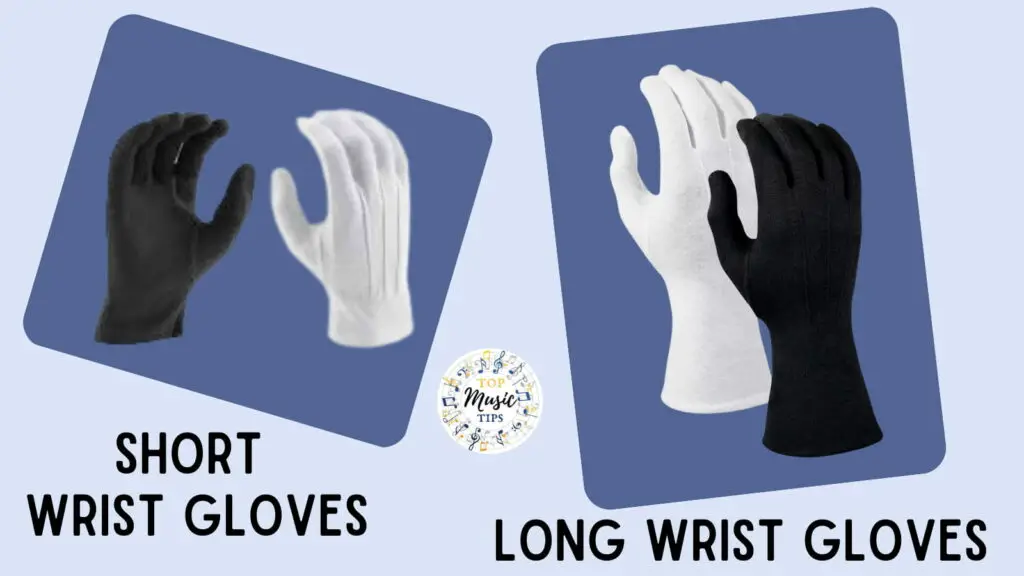
How to Measure Marching Band Gloves
In some Marching Bands, you might be asked to measure your hand to determine what size gloves you will need to buy.
Tip: To measure your hand for the best glove size, you will need a cloth measuring tape and a friend to help you.
Have your friend take the measuring tape, place it across your dominant hand’s palm, and knuckles about a half inch below the fingers. Don’t tense your fingers while being measured; ensure the measuring tape is not pulled too tight across your hand.
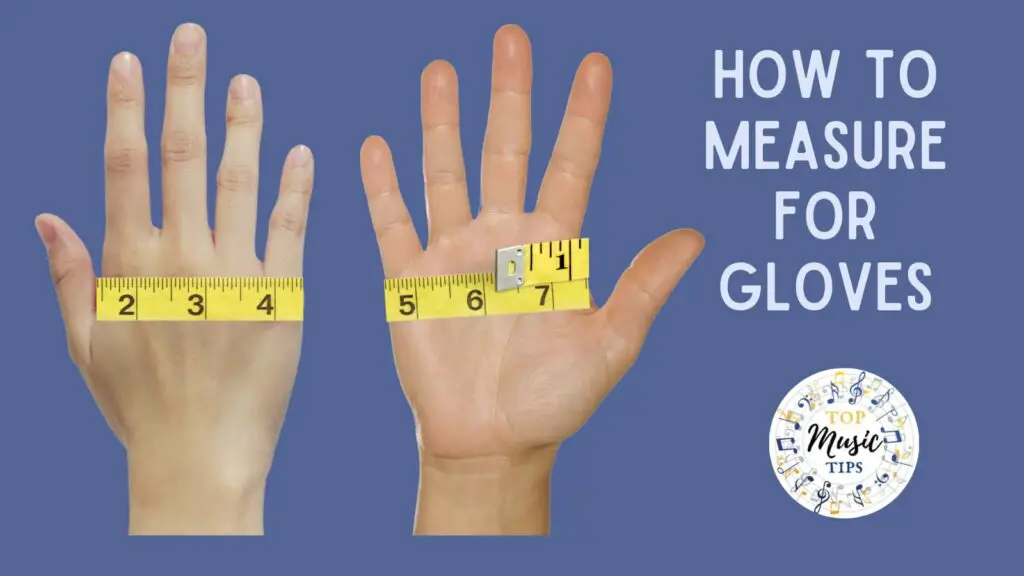
Most marching band supply companies will include instructions on how to measure your hand and provide a sizing chart for you to select the best glove based on the measurement of your hand.
🎵 Note: It is important to know that every person’s hands are different, and yours might not be the same size for both hands. Measuring your hand to determine glove size should be considered a reference point, not the exact measurement for gloves.
You should know your hands enough by the time you enter a marching band to know if you need a Small, Medium, or Large glove. It is easy to look at your hand and consider how wide and thick your hands are when buying gloves.
You should always buy multiple pairs of Marching Band gloves at the start of each season. As you wear the cotton band gloves, they can become stretched out and lose their shape.
🎵 Tip For Woodwind Plaers: if you have to cut the fingertips off of your gloves, the finger area can become very loose and get snagged in the keys of your instrument. Having backup gloves is a must!
🎵 Tip For Brass Players: Your gloves may become loose at the wrists, and pulling them down constantly can stretch the fabric out of shape. Not only can the gloves lose shape, but they will also get dirty faster than you think after wearing a fresh pair of white cotton Marching Band gloves while at a game, you will be surprised at just how dirty they will be.
The gloves will absorb the sweat from your hands, which can make them look yellow (just like a white baseball hat can show sweat stains if you wear it for long enough) if you touch a wall, the stands, or even a fan’s hand you will collect dirt and grime on your hands.
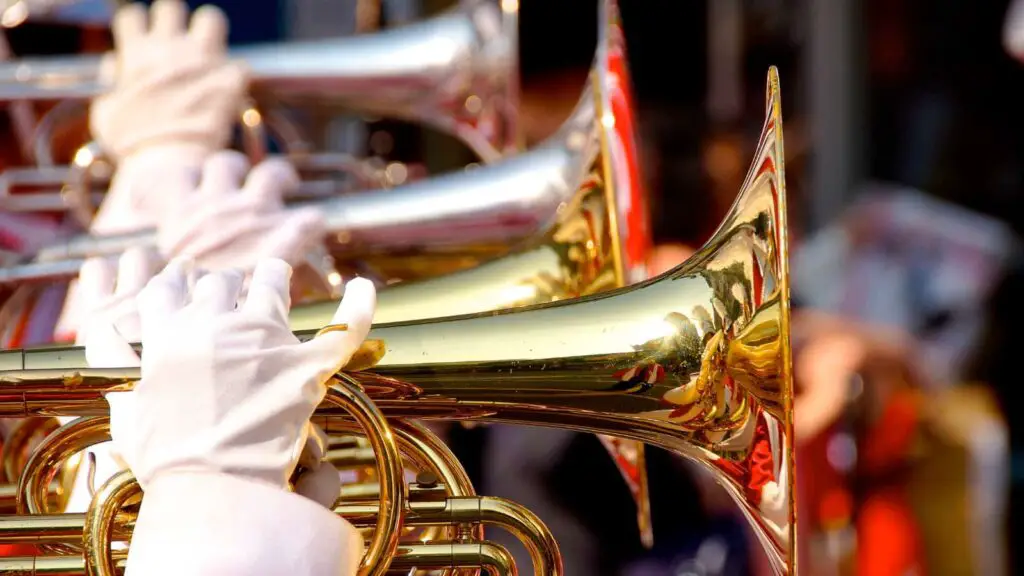
Owning multiple pairs of cotton Marching Band gloves allows you to rotate the pairs of gloves you use each week. Have one fresh/clean pair for game day and another being cleaned or hanging to dry from the last time you used gloves.
Tip: If you have multiple pairs of Marching Band gloves, always bring a spare pair in your case or gameday backpack (if your band has them) because the gloves can easily go missing.
Sometimes returning to the stands after halftime and getting ready for the second half of a game, you will take off your gloves for some reason and only be able to find a single glove when you are ready to put them back on. Marching Band gloves are pretty inexpensive and can cost anywhere between $2.00 and $5.00, so it is easy to afford to buy several pairs at the beginning of each season.
How Do You Clean White Marching Band Gloves?
There are several ways you can clean your white Marching Band gloves, and how you choose to wash them is up to you.
Cleaning Method 1
One of the first ways to clean white Marching Band gloves is to toss them in the wash with other light-colored or white clothing items.
Use cold or medium temperature water and add detergent like normal. When they finish in the washing machine, take them out, clip them to a hangar, and let them hang dry.
They should be dry and ready to wear a day or two later.
Just repeat this process after every game, but it helps to own more than one pair of white Marching Band gloves if you do this, just in case you forget to wash your gloves during the week.
Note: If you have whitening detergent and want to use that to clean the gloves, that is perfectly fine. You do not need to buy a special detergent just to clean your white Marching Band gloves.
Cleaning Method 2
Another method for cleaning your white Marching Band gloves is to create a bleach bath and soak the gloves in there for a bit.
A bleach bath is a mixture (best to use a bucket or use a sink with a plug) of water and bleach. Equal parts water and bleach works, or use a mixture of ⅔ water and ⅓ bleach.
The water dilutes the bleach, so it isn’t as strong. Sometimes bleach can be too harsh on its own. Then just drop your gloves into the bleach bath, set a timer, and move on to the next thing you need to do. When the timer ends (start with 5 minutes), go and take a look at the gloves.
Tip: You can use chopsticks or tongs to pick your gloves up. Although the bleach is diluted, you don’t want to let your skin come into contact with bleach.
If the gloves are white and clean once again, hang them up to dry, and that’s it. If the gloves still look dirty after checking in on them after 5 minutes, place them back into the bleach bath, set a timer for 2-3 minutes, and check again. Repeat until the gloves are clean.
Cleaning Method 3
If you don’t like the first two methods for cleaning white Marching Band gloves, you can always hand wash them.
You can put the gloves on and run your hands under a faucet to get the gloves completely wet, or you can fill a bucket and place your hands in the bucket.
Once the gloves are wet, use detergent to wash your hands with the gloves on. After you finish scrubbing them, just turn on the faucet and run your gloved hands under the stream of water until the water runs clean and no more bubbles are dripping off the glove.
Remove the gloves and hang them up to dry.
🎵 Note: This method is the easiest, but it can stretch your gloves out even more because you are scrubbing the material against itself. Your best bet is to toss them into the wash each week or use a bleach bath.
Drying Marching Band Gloves
You can dry Marching Band gloves flat after washing them; however, it can make them smell like mildew, depending on where you live.
Hang drying the gloves can prevent a mildew smell and ensures both sides of the gloves will dry.
Tip: Do not toss your white Marching Band gloves into the dryer if they are made of cotton or nylon (another material used for gloves but not as popular). These fabrics will shrink when placed in a dryer, and you can ruin a pair of gloves that way.
If you accidentally end up with one or both gloves in the dryer, it is okay, but it should not be how you dry them going forward.
With white cotton Marching Band gloves, there will come a time when no matter how many times you have washed the gloves, they will eventually look gray, dirty, or become stretched out of shape and fit loosely. In that case, just throw them away. This is why having more than one pair of Marching Band gloves in rotation during the season is a good idea.
We hope this article has been helpful and informative for you in your musical journey. Please let us know if there is anything that we could add or change to make this article a better resource for our readers.
Please e-mail us at: [email protected] to let us know how we are doing!
Disclaimer: This post may contain affiliate links. We only recommend high-quality products that are used and recommended by real musicians. If you use these links to buy something we earn a small commission.
